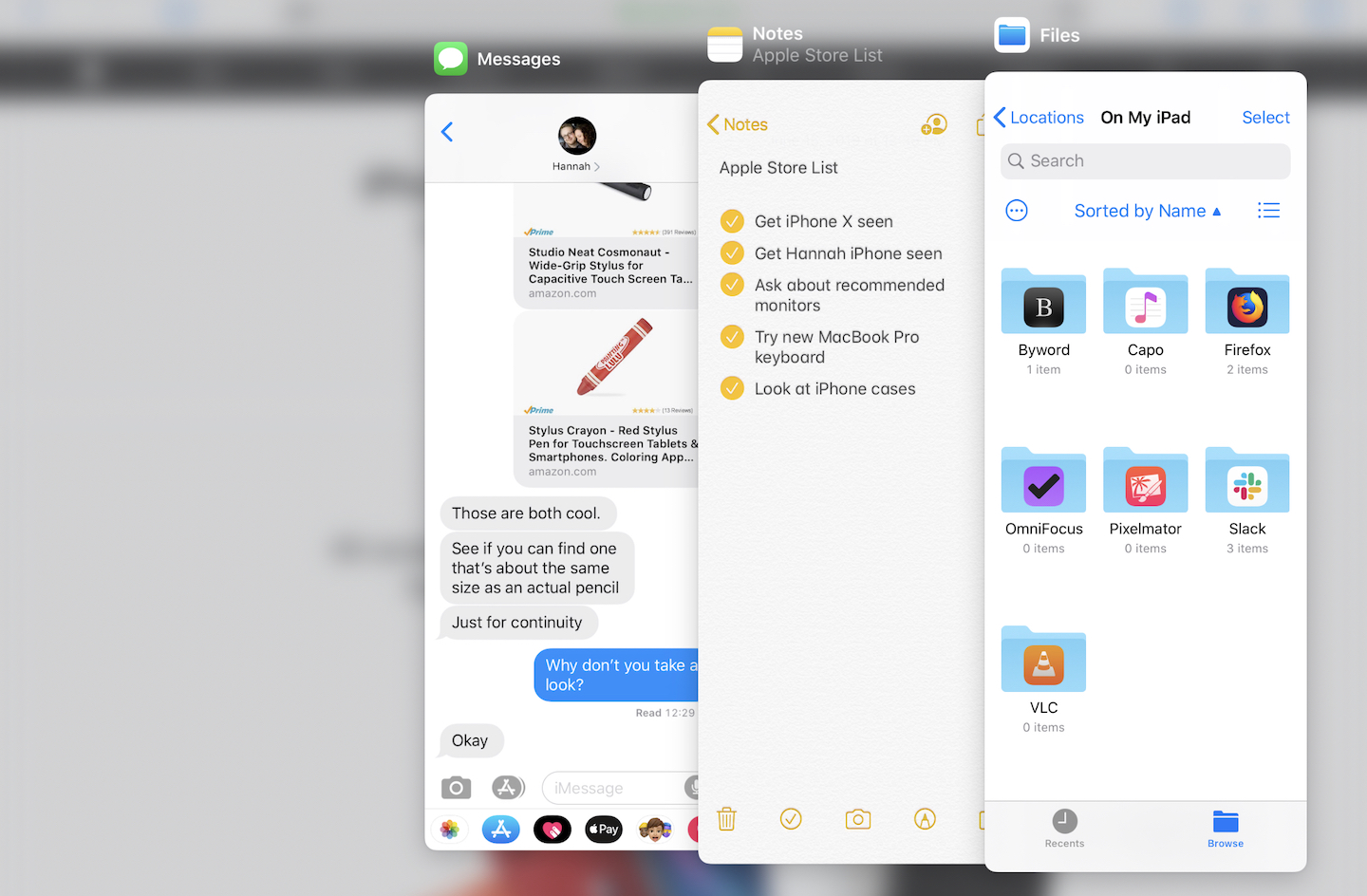What’s New in iOS and iPadOS
iOS 13 brings many new features in addition to speed increases, not least of all the fact that iOS has now been split into two operating systems: iOS and iPadOS! Here’s what’s new.
Unsupported Devices
Sadly, iPhoneOS 13 and iPadOS 13 drop support for many devices:
iPhone 5s
iPhone 6 and 6 Plus
All iPod touch models except the 2019 model
The original iPad Air
iPad mini 2 and 3
iPad
The iPad no longer runs iOS, but iPadOS! This year, the two operating systems have many of the same new features, but don’t be surprised if they diverge further in the future. Here’s what’s new on the iPad this year:
Safari: iPadOS 13 brings desktop-class Safari to the iPad, which means that web apps like Google Docs, Netflix, Squarespace, and YouTube now work in it.
Split Screen: You can now see two views from the same app in Split Screen mode, assuming the developer supports that feature. For example, drag a link out of Safari or a note out of Notes to the side of the screen to open Split Screen. Also, Split Screen now defaults to a 50/50 split between app views.
Slide Over: You can now store several app windows in Slide Over and quickly switch between them by swiping (Figure 1).

Figure 1: iPadOS 13 lets you juggle several apps in Slide Over. App Exposé: Apps can now have windows open in multiple spaces. For instance, you could have one space with full-screen Safari and another with a split between Safari and Maps. Tap an app’s Dock icon to see all the spaces that app is being displayed in.
Home screen: iPadOS can display many more app icons on the Home screen than before, and you can display Today View alongside your first Home screen’s app icons. Today View widgets can be pinned so they’re always available on screen.
Apple Pencil: Apple has cut the Pencil’s latency down to as low as 9 milliseconds—about half of what it used to be, making it smoother and more responsive. iPadOS offers a redesigned Pencil palette, lets you take screenshots with the Pencil, and features a new pixel eraser tool.
Keyboard: Pinch the iPad keyboard to shrink it down to an iPhone-sized keyboard, called the QuickType keyboard, that can be dragged anywhere on the screen and operated with one hand. You can swipe between letters to type on the QuickType keyboard, a feature Apple calls QuickPath.
Sidecar: macOS 10.15 Catalina lets you use an iPad running iPadOS as an external display to either mirror or extend your Mac’s desktop. You can even use an Apple Pencil to draw on the Mac’s screen through the iPad, sketch on the iPad and bring it to the Mac in a feature called Continuity Sketch, and many third-party Mac apps will offer special Apple Pencil support, like Adobe Illustrator, Affinity Photo, Final Cut Pro (natch!), and Sketch.
Peek and Pop: These features are no longer exclusive to 3D Touch and can be activated with a touch and hold. Try touching and holding on everything to see what happens!
Accessibility
iOS and iPadOS 13 offer interesting accessibility improvements:
Voice control: Perhaps the most exciting feature of iOS 13 is Voice Control, which lets you control every aspect of your device with your voice by calling named screen elements or interacting with an on-screen grid. Check out my video showing off Voice Control, which bears a striking resemblance to the Esper machine in the movie Blade Runner. Try it out in Settings > Accessibility > Voice Control.
Mouse support: Yes, that’s right, you can now use a Bluetooth or USB mouse with iOS! Plug in your mouse with the appropriate adapter and go to Settings > Accessibility > Touch > AssistiveTouch, turn on AssistiveTouch. You can program the individual pointer buttons by going to Settings > Accessibility > Touch > AssistiveTouch > Pointing Devices.
See iOS Accessibility.
Camera and Photos
The Camera and Photos apps gets a few improvements in iOS 13:
Portrait Lighting improvements: The Camera app on the iPhone XS, XS Max, XR, and later lets you adjust the intensity of the Portrait Lighting effect, and offers a new High-Key Mono effect for black-and-white portraits.
Redesigned Photos tab: The Photos tab has been dramatically redesigned. Photos lets you easily switch between Years, Months, and Days views without losing your place in any view. Photos no longer display as a static grid, but shows photos in different sizes, highlighting significant events, and it even shows moving previews of Live Photos and videos (Figure 2). Photos will also try to hide duplicate photos and clutter in these views. There’s still the All Photos view if you want to view a square grid of photos in strict chronological order with no gimmicks. You can pinch to zoom in and out of all of these views.

Figure 2: The Photos tab is more dynamic. Photo editing: Photo editing has been overhauled and standardized into a set of circles and sliders that let you control the intensity of each effect. You can now also adjust the intensity of each editing effect, and preview them individually. Photos can now straighten and crop photos automatically. And you can pinch-to-zoom as you’re editing to zoom in on what you’re working on.
Video editing: Most of the same editing tools are now available for videos, including rotation so you can easily fix those videos accidentally captured in portrait mode (Figure 3). Those video edits are now nondestructive and can be undone.

Figure 3: You can now easily fix videos taken in the wrong orientation. Birthdays: Photos can remind you of birthdays. If you have a birthday assigned to someone in your People album, it will show you photos of that person on their birthday.
Live Photos: Photos will extend Live Photo playback for each Live Photo you’ve taken within 1.5 milliseconds of each other.
Search: You can now combine multiple search terms without tapping each word.
Screen recordings: There is now a built-in smart album for screen recordings.
See Capture Camera Basics and Get to Know Photos.
iPhone 11 and 11 Pro
The iPhone 11 and 11 Pro add a number of new camera features:
Ultra-wide shots: Both iPhone 11 models features lenses that allow for ultra-wide shots.
Night mode: The iPhone 11 and 11 Pro have improved low-light photography with Night mode.
Smart HDR: Improved HDR in the new iPhones can differentiate between people and other objects, improving the HDR effect on skin tones.
QuickTake: You can take still photos while taking a video, but with QuickTake, you can now shoot a video while in a still photo mode.
Slow-motion selfies: The front video cameras in the iPhone 11 and 11 Pro can take video in slow motion, something Apple calls “slofies.”
The interface for the Camera app on these phones is significantly different than on previous phones. For an overview, see About the Camera iPhone 11 and 11 Pro Camera App.
Dark Mode
Apple has added the much-requested Dark Mode to iOS and iPadOS. It automatically makes many screen elements dark, and that will expand as third-party developers add support for it. Try it out in Settings > Display & Brightness, and while you’re there you can set it to automatically turn Dark Mode on and off throughout the day. You can also activate it from Control Center—see Other Control Center Functions.
HomeKit
Apple improves home automation in iOS 13, though maybe not as much as we’d like:
Home app refresh: Accessory controls have been redesigned.
HomeKit secure video: HomeKit security cameras can securely record video directly to iCloud. The amount of space depends on your iCloud storage plan: 200 GB plans can recording up to 10 days of footage for one camera. 2 TB plans can keep 10 days for five cameras.
Siri Shortcuts: You can now add Siri Shortcuts to automations.
HomeKit-enabled routers: Some third-party routers (so far from Eero, Linksys, and Spectrum) will support a new security feature that segregates HomeKit devices from the rest of your network.
To learn more about HomeKit, check out my book Take Control of Apple Home Automation.
Files
The Files app includes a number of desktop-class improvements:
External drive support: Files can access files from a USB drive, SD card, or hard drive.
Downloads folder: iCloud Drive now provides a Downloads folder where Safari can stash files it downloads.
Zip and unzip: Files can now unzip archives and zip compress folders.
Document scanner: You can directly scan documents into the Files app with your device’s camera.
File server support: Files connects to SMB servers.
Create folders: You can now create folders in the Files app!
See Use the Files App.
Apple’s Mail app gets new text formatting options and other niceties:
Text formatting: Mail has a new text formatting pane that lets you choose fonts, adjust text size, apply styles, adjust indention, create lists, and more. That’s combined with a new, easier-to-use attachment selector.
Mute threads and block senders: You can mute an email thread or block a sender and that will be applied across your Apple devices.
Extended reply menu: When you go to reply to an email message, you’ll be presented with a panel of actions including reply, forward, trash, flag, and mark as junk.
Address autocomplete: When adding an email recipient, if that recipient has more than one email address you can choose the preferred address from a dropdown menu.
To learn more about Mail, see Joe Kissell’s book Take Control of Apple Mail; an update to cover iOS 13 and iPad OS 13 (as well as Catalina) is expected in the relatively near future.
Maps
Apple’s Maps app gets some much-needed love in iOS and iPadOS 13:
New Map Data: Tired of being the butt of jokes, Apple’s Maps team traveled over four million miles to create a whole new data set for Maps that surpasses even Google’s leveling of mapping detail. Apple’s new maps will be available across the entire United States by the end of 2019 and in more countries in 2020. (Figure 4)

Figure 4: Apple’s new maps are substantially more detailed than its old ones. Look Around: In Apple’s attempt to catch up with Google Maps, it now finally has an answer to Street View, called Look Around, which lets you virtually walk around a location. It’s much smoother than Google’s Street View, but not as universally available (Figure 5). To start, Look Around is only available in Honolulu, Las Vegas, and San Francisco.

Figure 5: Another neat aspect of Look Around is being able to set it aside in its own window as you browse the map. Favorites: You can now set up favorite locations for quick access.
Collections: Maps lets you create collections of locations that you can share with others. For instance, you could create a collection of your favorite restaurants in a vacation spot.
Navigation improvements: Siri now delivers more natural directions, like “turn left at the next traffic light” instead of “in 1000 feet turn left.” The new junction view helps get you in the correct lane before turning or entering an elevated road, reducing the chance of missing a turn. Transit directions have been enhanced with transit schedules and real-time information like cancelations and outages. Maps also now offers up-to-the-moment flight information.
Place cards: Location cards can now show dynamic information like movie showtimes.
Customer feedback: Apple has redesigned the customer feedback experience to make it easier to point out incorrect information.
Share ETA: You can now share your ETA while navigating. See Share Your ETA.
See Use Maps.
Messages
Messages isn’t a focus of this year’s updates, but Apple made some big improvements to search:
Search: Search is dramatically improved in Messages. Tapping the search box shows suggested contacts, links, and photos. Searching for a term exposes individual conversations with those terms, Web links from messages, and attachments.
Details: The Details pane better organizes links, locations, and attachments.
Share name and photo: You can have Messages automatically share your name and photo, either with contacts or anyone. You can use a picture of yourself from Photos, an Animoji, a Memoji, or a simple text monogram. You can also add filters to your photo. You’ll be prompted to set this when you first open Messages, or you can change it later in Settings > Messages > Share Name and Photo.
Animoji and Memoji: There are three new Animoji characters: mouse, octopus, and cow. There are a multitude of new Memoji options, including makeup, new hairstyles, piercings, and braces.
Animoji and Memoji stickers: You can now insert Animoji and Memoji stickers from the emoji keyboard. The stickers are generated automatically from your existing Memoji, which you can create in Messages by tapping the Memoji Stickers
 button in the app drawer while viewing a conversation. All devices with an A9 chip or greater support these.
button in the app drawer while viewing a conversation. All devices with an A9 chip or greater support these.
See Master Messages.
Notes
The Notes app has some nice improvements:
Gallery view: You can now view your notes as a grid of thumbnails instead of as a text list. Tap the gallery
 button to switch views.
button to switch views.Sharing improvements: You can share entire Notes folders with another person and you can share a note as read only.
Checklist improvements: You can reorganize checklist items with drag and drop. Swipe right on a checklist item with one finger to indent and swipe left to outdent. There’s a new Sort Checked Items setting in Settings > Notes. If set to Automatically, Notes will automatically moved checked items to the bottom of the list.
Subfolders: You can create folders within folders.
Search: The search feature in Notes now suggests searches, like Shared Notes, Notes with Checklists, and Notes with Scanned Documents. Search can now find text inside PDFs.
See my book Take Control of Notes for much more on using Notes.
Reminders
The Reminders app has been redesigned from the ground up, with machine learning tools like Smart Lists, a quick toolbar to quickly insert items, and more sophisticated list management options, like nested lists and attachments. Note that if you want to use many of the new advanced features of Reminders, you will have to update to a new file format that will make your reminders inaccessible to devices running older operating systems. See Scholle McFarland’s book Take Control of Calendar and Reminders for complete details (the book will soon be updated to cover iOS 13 and iPadOS 13).
Safari
Safari has several nice improvements, including ways to download files and search for open tabs.
Downloads: Safari can now download files and as such features a downloads manager.
New start page: The start page suggests links from your browsing history, frequently visited sites, links sent to you in Messages, and more.
Website View menu: The Reader view button has been replaced with a multipurpose Website View menu that lets you zoom the text, hide the Safari toolbar, request the desktop version of a site, and accessing new per-site settings, such as automatic reader mode, automatically requesting the desktop version, and control over access to the camera, microphone, and location (Figure 6).

Figure 6: The new Website View menu. Photo upload resize: When uploading an image to a website, you can tap Choose Image Size to easily resize it.
Security: Safari history and open tabs are now synced through iCloud with end-to-end encryption. Safari will warn you if you try to sign up for a new account with a weak password.
Search for tab: Searching in the Smart Search field (what Apple now calls the address bar) reveals open tabs.
Sharing: You can share a webpage as a link or a PDF.
Tabs: Touch and hold a tab to see a menu that lets you close and sort tabs. You can also have Safari automatically close unused tags after a set length of time in Settings > Safari > Close Tabs.
Link previews: You can now hide link previews when touching and holding a link.
Self-contained web apps: When you save a webpage to your Home screen and launch it, it now launches in its own window instead of a Safari tab. It even keeps settings like cookies separate from Safari so you can use, say, a different login in the saved web app than you use with Safari.
See Go on Safari.
Sharing
Activity views (formerly known as the Share sheet) have been overhauled to offer one-tap sharing suggestions, and miscellaneous actions are now in a text list, clearly separated from the app sharing options. Some apps, like photos offer additional options, like stripping your location from a photo before sharing it, or sharing only an iCloud link instead of the actual photo (Figure 7).

Siri and Shortcuts
Automation officially arrived on iOS in the form of the Shortcuts app. You can use Shortcuts to edit photos, play music, control home automation accessories, tell loved ones how long it’ll take you to get home, and more. Shortcuts also lets you use Siri to launch automations.
Improved speech: Siri’s software-generated voice is now more natural and less robotic. Siri also has a new Indian English voice.
Third-party audio apps: Siri can now work with third-party audio apps to play music, podcasts, audiobooks, and radio.
Radio: Siri can now tune into radio station streams.
Siri intelligence: Siri offers recommendations in Maps, Podcasts, and Safari.
Siri integration: You can now pass Spotlight queries to Siri by tapping Ask Siri. See Search with Spotlight.
Shortcuts app: The Shortcuts app is now built-in with some design improvements. Siri Shortcuts have been removed from Settings > Siri & Search and moved to the Shortcuts app.
Shortcut action suggestions: When creating new shortcuts, the app will suggestions actions based on your usage.
Conversational shortcuts: When using Siri to trigger shortcuts, Siri can now ask followup questions.
HomeKit integration: You can create and manage HomeKit automations from the Shortcuts app and you can trigger shortcuts with HomeKit automations and vice versa.
Apple TV shortcuts: Shortcuts now lets you sleep or wake an Apple TV, launch Apple TV apps, and display an Apple TV remote.
Personal automations: Just as you’ve been able to use HomeKit to trigger actions in your house based on time and location, you can now do the same on your devices. For instance, you can play a certain playlist when you open an app. See Use Personal Automations.
See Speak to Siri and Take a Shortcut.
Text Editing
iOS 13 and iPadOS 13 greatly improve the keyboard and text editing:
Keyboard: On the iPhone keyboard and the iPad floating keyboard, you can now swipe over letters to type, which Apple calls QuickPath—alternative word choices appear in the QuickType bar.
Dictation: The Dictation feature now automatically detects which language you’re speaking, assuming the keyboard for that language is enabled in Settings > General > Keyboards > Keyboards.
Cursor: You can now pick up the text cursor with a finger and drop it where you want it.
Text selection: Touch and hold to begin selecting text. Otherwise, double-tap to select a word, triple-tap to select a sentence, or quadruple-tap to select a paragraph. You can also double-tap to select addresses, phone numbers, email addresses, and other bits of information.
New gestures: Pinch in with three fingers to copy, do it again to cut, and pinch out to paste. Swipe left with three fingers to undo and swipe right with three fingers to redo.
Multiselect: Select multiple email messages, files, and folders by tapping and dragging with two fingers.
Scroll bar: You can now touch and hold on the scroll bar in long documents to zip up and down the page.
Fonts: Type designers will be able to offer custom fonts in the App Store. You can manage installed fonts in Settings > General > Fonts.
See Command Keyboards.
Other
Last, but definitely not least, here are other improvements in iOS 13 and iPadOS 13:
AirPods: You can now pair two sets of AirPods to one device and listen to both at once.
App Store: You now have the option to download large apps over a cellular connection. The App Store now has full support for Arabic and Hebrew.
Augmented Reality: ARKit 3 lets developers add motion capture, and it features people occlusion, making it so augmented reality content looks natural either in front of or behind other people.
Books: There is now a five-minute-per-day reading goal. The more daily reading goals you meet, the more achievements you unlock. That counts for both traditional and audio books. There’s a new, built-in Books Read This Year collection you can share to show off.
Calendar: You can now add attachments to events.
CarPlay: Apple’s CarPlay has been overhauled in iOS 13 with a new dashboard, Hey Siri support for automaker systems, a new Light mode, views independent from what’s displayed on the iPhone, and more. Check out AppleInsider’s video on what’s new in CarPlay.
Contacts: There are now hundreds of new relationship labels, and you can create Memoji for yourself and your contacts inside the Contacts app.
Control Center: Touching and holding the Bluetooth and Wi-Fi icons in Control Center’s Networking Platter lets you view available networks and devices to connect with. The QR code feature is now distinct from the Camera. See Take Control of Control Center.
Do Not Disturb While Driving: No longer turns on when using public transit.
Enterprise: New enterprise features include data separation when using your own device with enterprise systems, managed Apple IDs for employees, modern authentication for device enrollment, and APIs for single-sign-on with Face ID and Touch ID.
Find My: The Find My iPhone and Find My Friends apps have been combined into the new Find My app, which can even find devices that are offline. See the TidBITS article How Apple’s New Find My Service Locates Missing Hardware That’s Offline.
Full-Page Markup: When taking a screenshot of a webpage in Safari, an email in Mail, and content in some other apps, when you tap the thumbnail you have the option to expand the screenshot to the entire webpage or email message. There is now also an opacity adjustment.
Game controllers: iOS 13 and iPadOS 13 can pair with PlayStation 4 and Xbox One game controllers.
Health: The Health app has been redesigned, with a much clearer layout. There’s now an entire set of metrics to track female reproductive health and fertility, hearing, and toothbrushing.
HomePod: The HomePod can now distinguish between voices of family members and offer a personalized experience for each person. You can now Handoff music playback from your iPhone to a HomePod.
Icons: Apple has a new standardized SF Symbols icon set, which it uses in its own apps and has provided to developers.
Low Data Mode: The new Low Data Mode in Settings > Cellular > Cellular Data Options > reduces app data use on cellular networks. See Manage Your Data.
Music: You no longer swipe up on a playing song to see lyrics and Up Next. Instead, you tap buttons while viewing the current song. The Music app now shows time-synced lyrics when you press the lyrics
 button. Up Next
button. Up Next  has been tweaked, displaying repeat and shuffle buttons.
has been tweaked, displaying repeat and shuffle buttons.Optimized Battery Charging: A new setting called Optimized Battery Charging in Settings > Battery > Battery Health holds off on charging the battery past 80% until it thinks you need it, in order to reduce battery aging. See Improve Battery Life.
Peek and Pop: You no longer need 3D Touch to activate peek and pop, just a touch and hold.
Performance: Apple claims that apps launch twice as fast, Face ID unlock is up to 30 percent faster, app downloads will be 50 percent smaller, and app updates will be 60 percent smaller.
Phone: You can turn on Silence Unknown Callers in Settings > Phone to send calls not in your contacts to voicemail. The Emergency SOS feature no longer automatically calls emergency services by default (see Deal with Emergencies).
Screen Time: Individual app limits are now easier to access, in Settings > App Limits, and you can combine any combination of apps and websites. Usage data now spans 30 whole days.
Stocks: More Apple News feeds have been added to Stocks, including those from Apple News+ if you’re a subscriber.
Voice Memos: You can now pinch to zoom while editing a recording to zoom in on the waveform.
Volume control: The Volume control indicator is now placed to the side of the screen and you can drag it up and down to adjust the volume. If you have an Apple audio device connected, like AirPods or a HomePod, the volume indicator shows an icon for that device.
Wi-Fi: iOS 13 and iPadOS 13 supports the new WPA3 standard. Your devices, including those in your Family Sharing circle, will automatically connect to an iOS 13/iPadOS 13 personal hotspot when you don’t have an internet connection. That hotspot connection is now persistent, so you stay connected even when your device sleeps. Your device will also suggest popular Wi-Fi networks at your location.
For more details, see Apple’s feature lists for iOS 13 and iPadOS 13.
